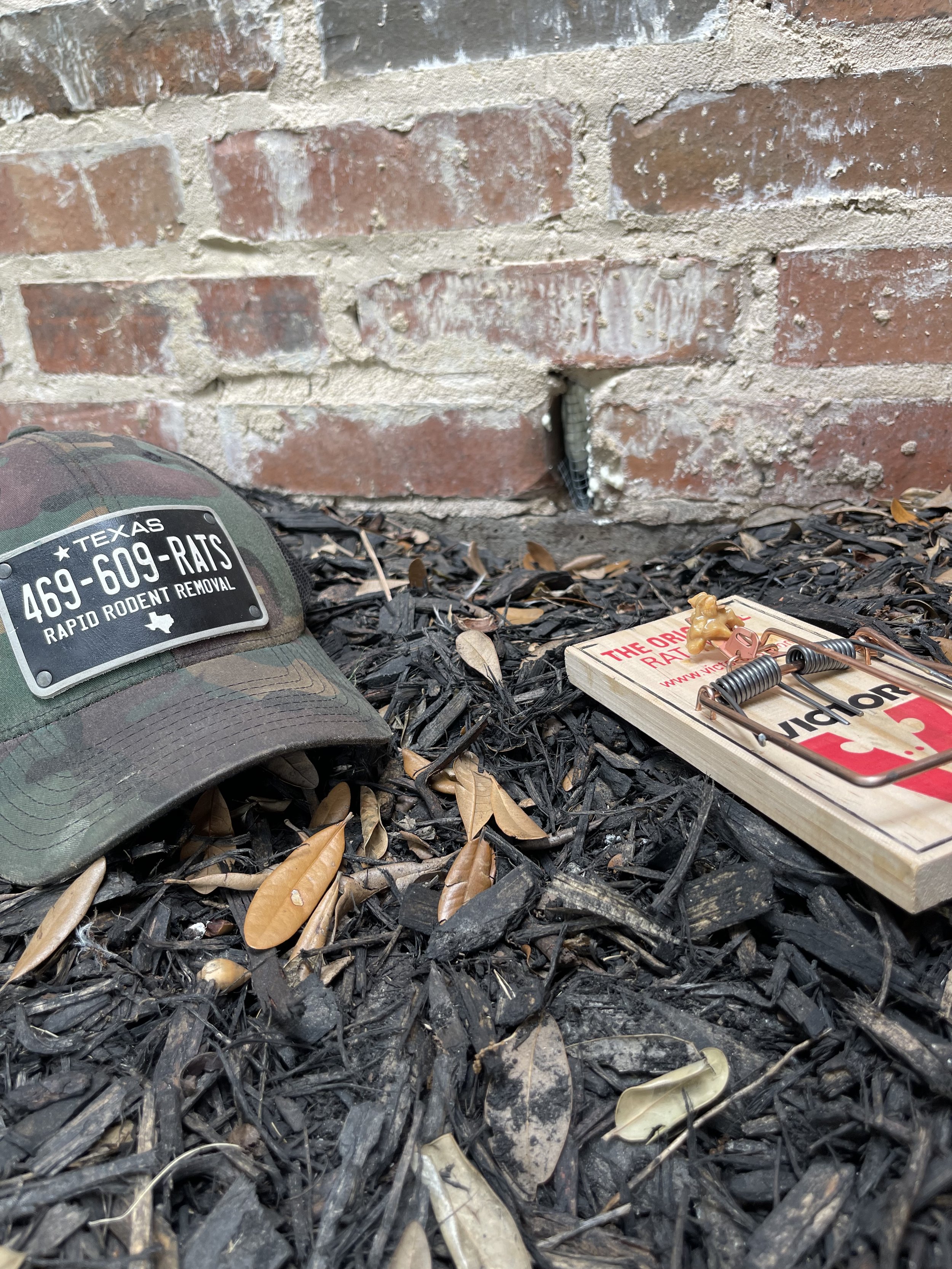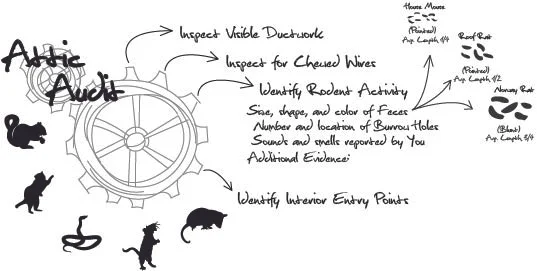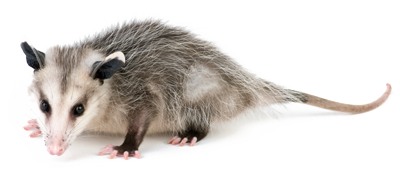RAT TRAPPING - HOW TO CATCH A RAT
Identify a spot where rats are likely to congregate, as indicated by the presence of rat poop, piles of grains, wood debris, or other natural areas. Set up a multitude of traps baited with peanut butter in the chosen location, but refrain from activating them initially. After several days, once the rats have discovered the baited traps, proceed to set the traps to effectively eradicate the rodents in substantial numbers..
HOW TO SET A RAT TRAP
Rat trapping, no matter the types of rat (roof rat / norway rat), over poison can be a better choice for several reasons but the main one being No bad odor: When rats die from poison, their carcasses can decompose in hidden locations, causing a bad smell. With traps, the rat can be found and disposed of easily, preventing foul odors. If you find yourself dealing with this type of situation you can read how to get rid of dead rat smell.
including:
Safety: Rat poison can be harmful to humans, pets, and wildlife if accidentally ingested. Traps, on the other hand, pose less risk to non-target animals and people.
Environmental impact: Rat poison can contaminate soil, water sources, and other parts of the environment. Traps have a lower environmental impact as they don't introduce harmful chemicals into the ecosystem.
Humane considerations: Some rat traps, like live-capture traps, can provide a more humane method of dealing with rodents, allowing for relocation instead of killing. Poison often results in slow and painful deaths for the rodents.
Target specificity: Traps can be placed in strategic locations to target specific rodent populations. Poison, however, can be accidentally ingested by non-target species, leading to unintended consequences.
Monitoring success: With traps, it is easier to monitor the success of your rodent control efforts, as you can see the captured rats. With poison, it is more difficult to know how many rats have been affected.
Secondary poisoning risk: When a poisoned rat is consumed by a predator, such as a bird of prey or a mammal, the predator may become poisoned as well. Traps eliminate this risk.
Reusable and cost-effective: Rat traps can be reused multiple times, making them a more cost-effective long-term solution compared to poison, which must be replaced after use.
In summary, rat traps can be a safer, more environmentally friendly, humane, and effective method of rodent control compared to poison. However, it is essential to use the right type of trap and place them in appropriate locations to achieve the desired results. Please exercise caution when you are setting rat traps, it can be very easy to hurt yourself. If you're not comfortable setting a rat trap or a mousetrap, please seek a pest control professional, OR scroll down to watch our video.
What does rat poop look like ?
What does mouse poop look like ?
What does squirrel poop look like ?
What does raccoon poop look like ?
What does bat poop look like ?
RAT TRAPPING NEAR ME
Dallas Rat trapping - McKinney Rat trapping -Frisco Rat trapping -Plano Rat trapping -Garland Rat trapping -Sachse Rat trapping -Wylie Rat trapping -Murphy Rat trapping -Richardson Rat trapping -Parker Rat trapping -Lucas Rat trapping -Allen Rat trapping -Fairview Rat trapping -Heath Rat trapping - University Park Rat trapping - Highland Village Rat trapping -Anna Rat trapping - Prosper Rat trapping - Rockwall Rat trapping - Rowlett Rat trapping -Mesquite Rat trapping -Irving Rat trapping -Carrollton Rat trapping -Lewisville Rat trapping - Little Elm Rat trapping - The Colony Rat trapping -Coppell Rat trapping - Carrollton Rat trapping
General precautions:
Always hold the trap properly
Never place a rat trap in areas accessible to kids or pets
PLACE RAT TRAPS IN THE RIGHT PLACES
Rats instinctively use walls and fences as guides. Therefore, they are unlikely to roam into the center of a room or yard. As such, traps are usually most effective when placed along a wall and in a low-light setting. Rat traps are most effective when hidden along paths where rats are most likely to travel.
To increase your odds of catching the critters, place traps inside closets, as well as under any furniture — like sofas, chairs or even cabinets — sitting along the walls. A clever way to lure rats into traps is to cut a hole on each side of a shoebox and place it along a suspected rat path with a baited trap inside. The box piques the rats curiosity on what’s inside — and once they go in, they won’t come back out.
TEACH RATS TO TRUST TRAPS
Even though rats have tiny heads, they are not as naïve as people often assume. A rat will be suspicious of new objects in its environment. This applies to rat traps, which could fail to lure prey if placed cold turkey out in the open.
When an infestation persists, one of the more effective methods of elimination involves getting rats accustomed to traps before setting them. To introduce a trap, place it in an active area but don’t set it. Allow rats to feed off this “safe” trap for a day or two. Once the critters have accepted this object as part of their regular turf, bait the trap again, but set it up to snap the next rat that crosses its path.
POISON-FREE rat trap BAIT
Just because a trap hasn’t snapped doesn’t mean it hasn’t had a visitor (best bait for a rat trap). It just means the rat in question was sly enough to pry away the bait without getting caught. If the snap trap didn’t do the trick the first time, simply try it again. There’s really no reason to add slow-working chemicals into the process considering how traps are designed to kill on contact.
Mixing poison with edible bait can cause numerous problems. For example, if a rat gets away with the bait and drags it across the floor, that poison could potentially spread through your flooring. This can be hazardous to any bare feet that cross over the area, especially if you have pets or children in the house.
Furthermore, poisoned bait increases the odds of a rat meeting its slow death in another part of the house. In that case, you could have difficulty locating its stinky, rotting corpse.
For the best chances of catching a rat in the trap, keep the bait small and centered on the trap. If you bait a trap with a dangling piece of shrimp, for instance, a rat could nab it by the tip, set off the trap harmlessly and feast on its treat elsewhere.
The house mouse averages 2.5 to 4 inches in length, with an additional length of equal measure for its tail. By contrast, the brown rat, also known as the Norway Rat, has a body that typically measures between 7 to 10 inches in length, with an additional 6 to 8 inches for its tail. With all things considered, rat traps need to be much larger than mouse traps. The trouble is, a lot of homeowners barely know the difference between rats and mice, let alone how to determine whether an infestation involves one or the other.
Before you can pick the best trap for the situation, it’s crucial to determine whether you’re dealing with a rat or mouse. For starters, the paw prints of a brown rat are typically around 20mm in width, whereas mice paw prints are generally under 10mm wide. Likewise, rat droppings are about the size of pumpkin seeds, and mice droppings are more the size of sunflower kernels. Additionally, mice tend to nest inside homes around the clock, whereas rats are often active indoors and out.
PLACE rat TRAPS PROPERLY ALONGSIDE WALLS
There are two clever reason why rats travel alongside walls: First, they use their whiskers to sense objects in front of them in the dark. By keeping one set of whiskers touching a wall, they can tell if they are still on the right path. Secondly, traveling along a wall provides protection – they only have to watch for trouble on the open-air side of their path. Therefore, a trap is most effective when it is placed against a wall at a 90-degree angle, with the trigger side placed closest to the wall.
1. IDENTIFY THE TYPE OF RAT PLAUGING YOUR HOME.
Did you know that there are more than 3 dozen types of rats? Tat vary in size, weight, nose, requiring different types of traps. For example, most snap and glue traps are designed to catch only the smallest rats and mice, so they won’t do any good if you’re dealing with a larger rodent, such as a roof rat or a norway rat.
2. RATS EAT WHAT YOU EAT.
Your choice of bait depends on the rat. Different subspecies of rats prefer vastly different types of food—and not all rats will eat cheese! You may have to try a variety of baits in order to find what works for you. Whatever bait you select, be sure it’s long-lasting. Chocolate, Peanut Butter , candy, and meat typically work the best.
3. STRATEGICALLY TRAP THEM.
Rapid Rodent Removal almost exclusively uses Ol School wooden Snap Traps by Victor. Not because were sponsored, one can dream right, but because they are simply the best. Rats are surprisingly smart. They’re not simply going to walk up to a trap that you drop in the middle of a room or yard. You have to place your trap strategically in an area they will travel through. This is another reason to identify the subspecies of rat you’re dealing with, because some like to travel near fence lines and other borders, and others prefer brush and tall grass.
4. PATIENCE WINS THE RACE.
Recognize that regardless of your rat-trapping method, it will take a little time to eradicate the problem. Be patient. Rats are intelligent and highly suspicious, so trapping takes time. Refill your bait and reset your traps as needed, be extremely patient when trapping around the Rat holes in yard.
Rapid Rodent Removal would love to set traps you
starting at 99$
Rat Trapping
THE MOST EFFECTIVE BAITS TO USE IN A RAT TRAP
There’s no need to spend more on specialty mouse baits just to catch mice. Just pick out any of these food baits in your kitchen to save more money:
1. PEANUT BUTTER & CHOCOLATE
Mice love eating seeds and nuts, which makes the flavor of peanut butter attractive for them. It also has high calorie and fat content that the mice need when living inside houses. Hazelnut spreads are also a good food bait if there’s no peanut butter at home.
When using peanut butter as food bait, avoid spreading too much peanut butter on the trap. Just put about a pea-sized amount of the peanut butter on the trap to attract mice. Chocolate is another high-calorie food that mice love. It also has a strong smell that attracts mice out of hiding. Since there are different varieties of chocolate, it’s important to find out which one works best when luring mice out of hiding. Most homeowners find that milk chocolate and regular chocolate do well in baiting mice. We prefer miniature recess peanut butter cups, or some piece of miniature chocolate candy similarly.
2. PET FOOD
Rats and Mice LOVE dog food, they love dog food so much they often eat dog feces.
Many animals like dogs and cats are useful in keeping mice at bay because they are the natural predator of mice. Their strong senses allow them to detect mice presence around the house. However, the pet food left in their feeding station attracts mice and rats.
These opportunistic feeders like eating leftovers of pet food because it’s rich in nutrients that rodents need to survive inside the house. Although they prefer wet food, these rodents also eat dry pet food that’s scattered around the house.
If the cat in the house likes to leave out food after they eat, make sure to clean up after them. Other homeowners utilize this chance to catch mice. Instead of cleaning the leftover food, they place traps near the cat feeder instead.
3. SEEDS AND NUTS
Mice love eating seeds and nuts. These rodents wouldn’t pass up the chance to eat them if there are seeds and nuts in the house. When using seeds and nuts to attract mice, go for bird seeds, sunflower seeds, and pumpkin seeds.
4. MARSHMALLOWS AND GUMDROPS
Marshmallows and gumdrops are cheap options used as mouse baits. They work well in luring mice out because of their high sugar content. Just put a piece or two on the mousetrap and let it do its trick.
5. DELI MEAT
Mice are willing to risk their lives for a few slices of deli meat like bacon and sausages. It doesn’t matter if they’re raw or cooked – the rodents take any deli meat that’s open for the taking. Some homeowners even use the cooked bacon’s grease because its strong smell lures mice out.
However, the main problem with using deli meat is that they spoil easily at room temperature. When using this kind of bait, make sure to check and replace it regularly.
6. FRUIT JAM
Fruit jam is also effective in attracting mice for the same reasons as peanut butter and hazelnut spread – they’re sweet and sticky. Just make sure to only put the right amount of jam on the trap’s far end so that the mouse is forced to set off the device.
The downside in utilizing fruit jams as mousetrap bait is that it also attracts other pests like cockroaches and ants. Check the mousetrap frequently to make sure that the bait hasn’t been consumed by other pests.
7. SOFT CHEESE
Most kinds of cheese aren’t as effective in attracting mice as peanut butter is. But if you still want to use cheese as bait, it’s better to use soft cheese instead of cheddar blocks. Camembert, brie, and blue cheese have strong smells that effectively attract mice out of hiding.
When Rapid Rodent Removal is also a roofing company , and Wildlife Experts, thats who we send out to your home, he doesn't come with a one-size-fits-all plan to offer you. Our Experts will conduct a thorough Home Inspection of your attics, crawl spaces, and exterior of your house in order to assess the problem and find possible solutions. We will take into account all presenting evidence found in and around your home and factor in your reports of sounds, smells, sightings, etc., in order to formulate a Custom Rodent Removal Plan that includes:
Resolving the Wildlife Problem
Sanitizing and Deodorizing Your Home
Repairing any damage to wires, ducts, interior walls, insulation, etc.
Preventing future issues by sealing up any possible entry points on the exterior of your home
Providing Customer Education throughout the entire process to empower you to maintain rodent control on your property
Here's a look into the mind of our experts and a sneak peek at what you will see when they arrive at your door:
Crawl space? Challenge Accepted!



















